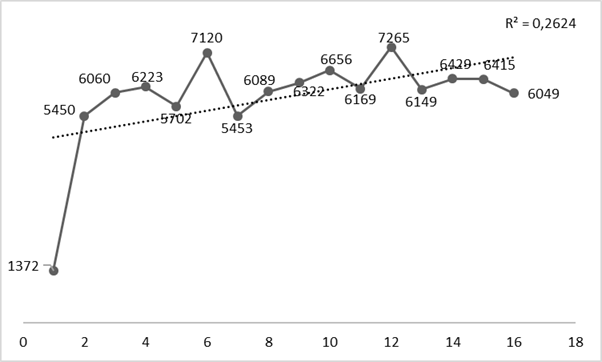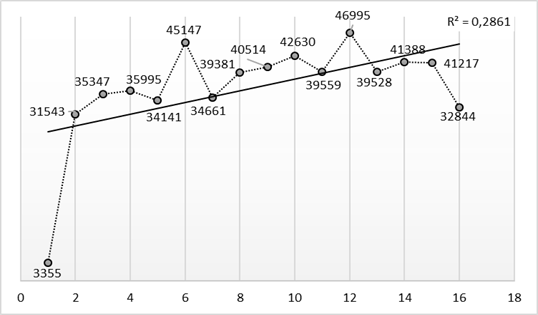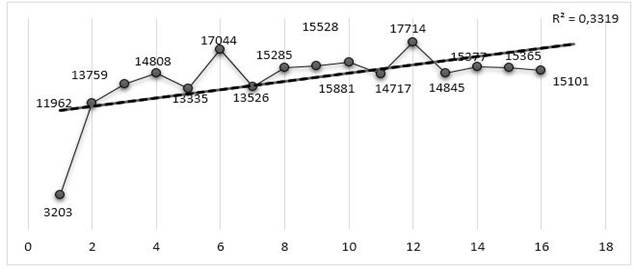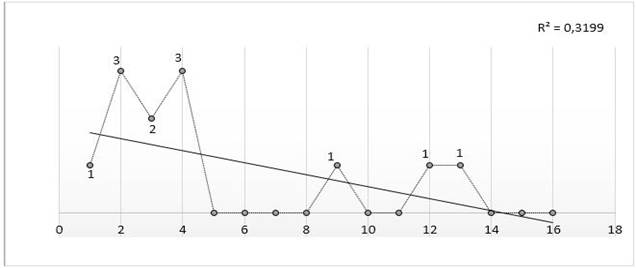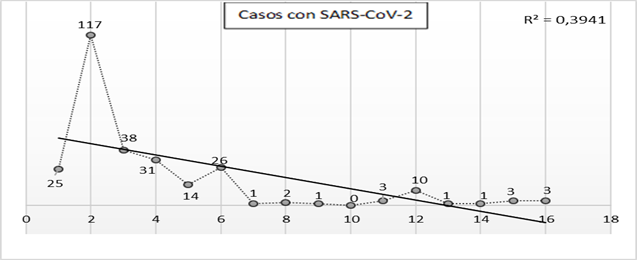Meu SciELO
Serviços Personalizados
Artigo
Indicadores
-
 Citado por SciELO
Citado por SciELO
Links relacionados
-
 Similares em
SciELO
Similares em
SciELO
Compartilhar
Revista de Ciencias Médicas de Pinar del Río
versão On-line ISSN 1561-3194
Rev Ciencias Médicas vol.26 no.2 Pinar del Río mar.-abr. 2022 Epub 01-Mar-2022
Original Article
Active surveys of medical students on respiratory symptoms to diagnose COVID-19 at Carlos Manuel Portuondo Teaching Polyclinic
1University of Medical Sciences of La Habana. Faculty of Medical Sciences Finlay-Albarrán. La Habana, Cuba.
2University of Medical Sciences of Pinar del Río. “Dr. Ernesto Che Guevara de la Serna. Pinar del Río, Cuba.
3University of Medical Sciences of Santiago de Cuba. Santiago de Cuba, Cuba.
4University of Medical Sciences of La Habana. Municipal Center of Medical Genetics. "Cristobal Labra" Polyclinic. La Habana, Cuba.
Introduction:
the university social responsibility has guaranteed the interaction of the academy with society in coping with COVID-19.
Objective:
to describe the main results of the active surveys on respiratory symptoms for the diagnosis of COVID-19 at Carlos Manuel Portuondo Teaching Polyclinic in Marianao municipality, La Habana province.
Methods:
an observational, descriptive and cross-sectional study was carried out at Carlos Manuel Portuondo Teaching Polyclinic between March and July 2020. The target group comprised 12,916 family homes and 41,673 patients allocated in this health area. The data generated by the daily surveys were used. Descriptive statistics and the estimation of the coefficient of determination (R2) were applied to conduct the analysis of data.
Results:
fourteen students participated in the active survey. A total of 35,41 % of the target group was contacted. It was obtained an overall average of 636 homes closed, with a decreasing trend (R2=0,1695). An average of 584 245 educational talks were given, with an increasing trend (R2=0,2861). The average number of people investigated increased (R2=0,3319), and a decreasing trend in the number of people with respiratory symptoms (R2=0,3941) and with the diagnosis of SARS-CoV-2 virus (R2=0,3199).
Conclusions:
the active surveys of medical students at Carlos Manuel Portuondo Teaching Polyclinic had an organizational and strategic level that guaranteed the link between the university academy and society in response to this new epidemiological emergency. The Cuban medical university as an educational institution has a social responsibility, developed with actions ruled by the scientific method and supported with the most modern technologies.
Key words: RESEARCH; COVID-19; CORONAVIRUS; SOCIAL RESPONSIBILITY; SOCIETY; EDUCATION, HIGHER; SCHOOLS, MEDICAL
INTRODUCTION
University extension as a social function of the universities of medical sciences in Cuba, and as one of its basic processes along with teaching and scientific research, has allowed the linkage of the university with society, in the sense of always responding to solve the needs of health the community suffers from everywhere it is placed. At the same time, it is nourished by the most current elements of its environment in social development and the growing challenges. In this way, the academy supports preventive actions in primary health care (PHC) with the mission of favoring an attitude of change and social transformation.
There have been dissimilar examples where the university has responded with its substantial processes to the development of the social environment together with the healthcare professionals of the Family Physician and Nurse Offices (CMEF). Active survey is an evidence of teamwork between medical science students, healthcare professionals and community leaders, among others.(1, 2)
Active survey is defined as a set of actions aimed at identifying the individual health status of the population, with the recognition of the existing risk factors and early identification of hidden morbidity, with the objective of being allocated to ensure follow-up and continuous care.2,3,4 This purpose is achieved thanks to the sustainability of the constant processes of scientific, clinical and epidemiological research by the family physician and nurse, together with their basic healthcare team.
COVID-19 is a calamity situation that requires the participation of the academia with its university students, teaming up with Primary Healthcare System personnel in the active detection of respiratory symptoms. This guarantees early attention and prevention of future complications, health promotion, increase in the level of knowledge related to the virus, among multiple actions.
Up to August 1, 2020, the world reached a figure of 17,354,751 infected people, 674,291 deaths associated with the disease. In Cuba, thanks to the measures taken by the government, its Ministry of Public Health (MINSAP), it has been possible to control the disease. There are 2 633 infected persons and 87 deaths. In these data, science has been responsible for the health of the people, sanitary actions, and preventive measures such as the development of active survey by the staff of the Family Physicians and Nurses Offices and students of medical sciences.
At Carlos Manuel Portuondo Teaching Polyclinic in the municipality of Marianao, students from Finlay-Albarrán School of Medicine from La Habana University of Medical Sciences are inserted. Initially, the survey was carried out by family physicians and nurses, according to the regulations of MINSAP, but, as in the rest of Cuba, on March 17, it was decided to progressively incorporate medical science students, as well as other groups of professionals. The evaluation of the processes constitutes one of the main links in health care; therefore, the present research was developed with the objective of describing the main results of the active survey on respiratory symptoms for the diagnosis of COVID-19 at Carlos Manuel Portuondo teaching polyclinic in Marianao municipality.
METHODS
An observational, descriptive and cross-sectional study was carried out at a Carlos Manuel Portuondo teaching polyclinic in Marianao municipality between March and July 2020. The target group consisted of 12,916 households and 41,673 patients allocated in this health area.
Patients residing in the geographical context served by the polyclinic and who were questioned and investigated by the staff involved in the survey were included. Those dwellings permanently closed and those dwellings whose inhabitants were not at home and those belonging to rural areas located in "farms" were excluded, the latter being assumed by family physicians.
The following variables were defined as study variables: the average number of students who conducted the survey, the average number of students attending the survey, the potential number of homes to be visited, the number of homes visited, the number of educational talks given to the population, the number of people surveyed, patients with respiratory symptoms, and SARS-CoV-2 positive cases.
The interview was used as the technique for obtaining the primary data, and the data related to the previously defined variables were included in an information collection model. First, the duo computed their data, taking into account the above variables. Then, the final report of the office survey was made, signed by the family physician and reviewed by the university professor linked to the survey. Finally, the professors issued the report of the Family Physician Office they attended, to the direction post of the active survey.
The data collected were stored in a database created for this purpose. Descriptive statistics and the estimation of the coefficient of determination (R2) were used for the analysis of data.
The informed consent of the persons surveyed and the confidentiality of the information on the part of the researchers were taken into account. Beneficence, non-malfeasance and justice were considered as bioethical elements to be taken into account in all surveys. The protection of the health of the subjects to be investigated, as well as of the researchers, was guaranteed. The standards on the bioethical principles of autonomy guided by Helsinki Declaration were taken into account.
RESULTS
A total of 114 medical students from the Schools of Medicine: Finlay-Albarrán (58), Victoria de Giron (25), Enrique Cabrera (4), Manuel Fajardo (7), Calixto García (1), Dentistry (1) and Health Technology Institutes (18) participated as researchers, distributed in 32 family doctor's offices (from 2 to 34), according to population density. The survey was carried out daily in the morning, working in duos, having a fixed working group up to 100 homes per student or 200 per duo. Positive cases with respiratory symptoms or fever were reported to the direction and sub-direction of Medical Care Assistance Department of the polyclinic.
During the survey period analyzed, an average of 90 students (78,94 %) attended daily. A total of 54,03 % of the potential number of homes according to student enrollment and 47,69 % of the total number of homes attended by the polyclinic were contacted. The rest of the homes were investigated by the Family Physician and Nurse Offices and the polyclinic staff. An average of 14,757 people was contacted, representing 35,41 % of their sample group (Table 1).
Table 1 Distribution of students, households and personnel related to COVID-19 survey at Carlos Manuel Portuondo Teaching Polyclinic in Marianao municipality between March and July 2020.
| Variables | No. | % |
|---|---|---|
| Students involved in the active surveys | 114 | 100 |
| Researchers attending the active surveys | 90 | 78,94 |
| Total number of dwellings in charge of the polyclinic | 12 916 | 100 |
| Potential number of homes to visit base on student enrollment | 11 400 | 88,26 |
| Homes visited during the period | 6 160 | 54,03* |
| Total number of inhabitants in charge of the polyclinic | 41 673 | 100 |
| Average number of people contacted | 14 757 | 35,41 |
*Calculation based on the potential number of homes to be visited according to student enrollment.
During the 16 weeks of active survey, the students conducted 652 918 visits to the dwellings. There were 276 persons with respiratory symptoms; of them 12 were confirmed positive for SARS-CoV-2 virus. This figure represents 0,028 % of the total population in charge of the polyclinic.
There was an overall average was 636 closed homes, a figure that showed a tendency to decrease as the study progressed (R2=0.1695). There was an upward trend in the average number of houses surveyed (R2=0.2624) (Fig. 1).
There were given 584 245 educational talks related to different aspects of the disease, with an increasing trend (R2=0.2861) (Fig. 2).
The average number of people surveyed increased (R2=0.3319) (Fig. 3), however, there was a downward trend in the number of people with respiratory symptoms (R2=0.3941) (Fig. 4) and with SARS-CoV-2 virus diagnosis (R2=0.3199) (Fig. 5).
DISCUSSION
University social responsibility (USR) is a new philosophy of university management that aims to renew the university's social commitment, facilitating innovative solutions to the challenges of higher education in the context of a globalized world.5
The school's approach to life is the first law of didactics. Medical education must be developed in the context of social phenomena, depending on this, the importance of university-society interaction, as the basis of education in the 21st century.
One of the greatest challenges for the schools of medical sciences is their effective link with society. This should be expressed in the identification of problems that constitute real social needs, assuming their solution through scientific research. Likewise, it must achieve the application of methods that promote learning and the extension projection of the processes generated in the university environment.6,7,8,9,10,11
In Cuba, USR in the medical sciences is facilitated by the inclusion of university students in Primary Health Care activities, by teaching in university polyclinics and performing their internships in Family Physician and Nurse Offices. They become teaching and research scenarios per excellence and at the same time basic units that guarantee the organization of preventive health actions in the community, such as active disease research and the implementation of projects and alternatives in search of solutions to solve the problems of society, increasingly demanding greater participation of academia.12
Primary Health Care constitutes the fundamental pillar of the health care system and occupies a scenario in constant transformation with the incorporation of new technologies to medical practice and the universalization of education, where the main efforts are focused on the improvement of the Program of Comprehensive Medical Care to the Family and the Community.1
During the active survey period, the totality of students varied due to multiple reasons, among them, their transfer to polyclinics close to their areas of residence, the progressive incorporation of students as they were summoned to the survey and the reincorporation to semi-presence teaching activities. Another influential factor was the decompensation of chronic and acute medical illnesses, being contacts of suspected cases and daily rest by right.
During the survey, approximately half of the homes attended by the polyclinic were guaranteed to be surveyed by the students, the rest was guaranteed by the healthcare personnel of the Family Physician and Nurse Offices, reinforced by the government officials of the municipality who controlled the quality of the survey, finally achieving 100% of the homes visited.
The upward trend in the number of houses surveyed, educational talks and people contacted depended on the period or moment of the survey, experiencing its highest frequencies in the final stage of the survey. Similarly, another positive factor was the achievement in social awareness of the population, which made it possible to provide accurate and timely information on the daily health status of family members.
There was an upward trend in the number of people contacted, which coincides with the results obtained by different studies, where the number of cases surveyed increased 9 times during the period. The jumps in the increase corresponded to the progressive entry of new screening groups and to the reordering.15,16,17
Active house-to-house survey is an effective method for prevention and early diagnosis of clinical conditions in Primary Health Care. It will continue to be the main instrument of the national healthcare system to guarantee public health.16
The number of confirmed positive cases had a decreasing behavior as the inquiry progressed, and the highest number of cases coincided with the highest number of people with respiratory symptoms. However, the number of positive cases in the polyclinic was higher than that obtained by Antonio Maceo polyclinic in El Cerro municipality,2 which only obtained two cases, representing 4,5 % of the 44 cases confirmed in the municipality.
Cuba has directed all its efforts and resources to the promotion, prevention, control and treatment of COVID-19. As an innovative element, it uses active survey for clinical signs of acute respiratory infections and/or non-specific febrile syndrome and the follow-up of risk groups. This is not the first time that Cuba has used active surveys in the diagnosis of infectious diseases for the protection of the people's health.2,12,13
The greatest contribution of this research was to highlight the social responsibility of La Habana University of Medical Sciences through its faculties, by developing its missions of education, research and social dimension in interaction with family physicians and nurses, community leaders, and with the participation of society itself, as key actors to cope with of this new epidemiological emergency.
It is concluded that the active survey of medical students at Carlos Manuel Portuondo Teaching Polyclinic in Marianao municipality, La Habana province, had an organizational and strategic level that guaranteed the link between the university academy and society in response to this new epidemiological emergency. The Cuban medical university as an educational institution has a social responsibility, developed with an action ruled by the scientific method and supported with the most modern technologies.
REFERENCES
1. García-Herrera A, Medina-Tápanes E, Martínez-Abreu J, Mestre-Cárdenas V, Moliner-Cartaya M. Pesquisa activa de pacientes sintomáticos respiratorios, esencia de la prevención de la COVID 19. Revista Médica Electrónica [Internet]. 2020 [citado 30/12/2021]; 42 (2): [aprox. 3 p.]. Disponible en: Disponible en: http://www.revmedicaelectronica.sld.cu/index.php/rme/article/view/3864 1. [ Links ]
2. Montano-Luna JA, Tamarit-Díaz T, Rodríguez-Hernández O, Zelada-Pérez Md, Rodríguez-Zelada Dd. La pesquisa activa. Primer eslabón del enfrentamiento a la COVID-19 en el Policlínico Docente “Antonio Maceo”. Rev haban cienc méd [Internet]. 2020 [citado 30/12/2021]; 19(0): [aprox. 0 p.]. Disponible en: Disponible en: http://www.revhabanera.sld.cu/index.php/rhab/article/view/3413 2. [ Links ]
3. Beltrán-llevador J, Íñigo-bajo E, Mata-segreda A. La responsabilidad social universitaria, el reto de su construcción permanente. Universia [Internet]. 2014 [citado 30/12/2021]; 14: 3-18. Disponible en: Disponible en: http://www.scielo.org.mx/pdf/ries/v5n14/v5n14a1.pdf 3. [ Links ]
4. Montano-Rodríguez F, Guillén Pereira L. Realidad y perspectiva de la Responsabilidad Social Universitaria en la Universidad Metropolitana del Ecuador. Espacios [Internet]. 2019[citado 30/12/2021]; 40(26):17. Disponible en: Disponible en: http://www.revistaespacios.com/a19v40n26/19402617.html 4. [ Links ]
5. Condori M, Reyna Gustavo A. Percepción de la responsabilidad social universitaria en estudiantes de la Facultad de Sociología de una universidad pública de la ciudad de Huancayo, Perú. Espacios [Internet]. 2019[citado 30/12/2021]; 40(39):8. Disponible en: Disponible en: https://www.revistaespacios.com/a19v40n39/a19v40n39p08.pdf 5. [ Links ]
6. Fernández-Díaz A. La interrelación instituciones universitarias - comunidad, un modelo participativo que lo promueve. Transformación, [Internet]. 2019[citado 30/12/2021]; 15(1): 27-38. Disponible en: Disponible en: http://scielo.sld.cu/pdf/trf/v15n1/2077-2955-trf-15-01-27.pdf 6. [ Links ]
7. Cobas-Vilches ME. La universidad cubana y su vinculación con la sociedad por el desarrollo sostenible. Edumecentro [Internet]. 2018[citado 30/12/2021]; 10(2):1-5. Disponible en: Disponible en: http://scielo.sld.cu/scielo.php?script=sci_arttext&pid=S2077-28742018000200001 7. [ Links ]
8. Severino-González P, Gaete Quezada R. Análisis bibliométrico de la producción científica sobre responsabilidad social en universidades chilenas. Espacios [Internet]. 2019[citado 30/12/2021]; 40(15):13. Disponible en: Disponible en: http://www.revistaespacios.com/a19v40n15/a19v40n15p13.pdf 8. [ Links ]
9. Forero-Jiménez MY. Modelo de responsabilidad social universitaria: una propuesta para las instituciones colombianas. rev. investig. desarro. innov [Internet]. 2019 [citado 30/12/2021]; 9(2): 249-60. Disponible en: Disponible en: https://revistas.uptc.edu.co/index.php/investigacion_duitama/article/view/9160 9. [ Links ]
10. Proenza-FernándezL, Gallardo-Sánchez Y Figueredo-Remón R . Caracterización del comportamiento académico en estudiantes de medicina frente a la pesquisa de la COVID-19. MULTIMED [Internet]. 2020 [citado 30/12/2021]; 24(3) Disponible en: Disponible en: http://www.revmultimed.sld.cu/index.php/mtm/article/view/1949 10. [ Links ]
11. del Huerto Marimón ME. La extensión universitaria desde una perspectiva estratégica en la gestión integral de la universidad médica contemporánea. Educ Médica Super [Internet]. 2012 [citado 30/12/2021]; 26(4):531-40. Disponible en: Disponible en: http://scielo.sld.cu/scielo.php?script=sci_arttext&pid=S0864-21412012000400006 11. [ Links ]
12. Mawad-Santos M, Escobar-Pérez Y, Ojeda-Herrera R, Sánchez-Alonso N, Urquiza-Yero Y. Satisfacción acerca de la pesquisa asociada a la COVID-19, realizada por estudiantes de las ciencias de la salud. Revista Electrónica Dr. Zoilo E. Marinello Vidaurreta [Internet]. 2020 [citado 30/12/2021]; 45 (4) Disponible en: Disponible en: http://revzoilomarinello.sld.cu/index.php/zmv/article/view/2347 12. [ Links ]
13. Molina-Raad V. Caracterización del componente estudiantil en la pesquisa activa relacionada con la COVID-19. Revista Electrónica Dr. Zoilo E. Marinello Vidaurreta [Internet]. 2020 [citado 30/12/2021]; 45 (3) Disponible en: Disponible en: http://revzoilomarinello.sld.cu/index.php/zmv/article/view/2260 13. [ Links ]
14. Renzo Aquino Canchari C, Ospina Meza RF. Estudiantes de medicina en tiempos de la COVID-19. Educ Med Super [Internet]. 2020[citado 30/12/2021]; 34(2):2-5. Disponible en: Disponible en: http://scielo.sld.cu/scielo.php?script=sci_arttext&pid=S0864-21412020000200001 14. [ Links ]
15. Santos-Velázquez T, Panizo-Bruzón S. Acciones educativas para atender la diversidad estudiantil en Estomatología en el contexto de la COVID-19. Revista Electrónica Dr. Zoilo E. Marinello Vidaurreta [Internet]. 2020 [citado 30/12/2021]; 45 (4) Disponible en: Disponible en: http://revzoilomarinello.sld.cu/index.php/zmv/article/view/2334 15. [ Links ]
16. Guilarte Rojas CY. La pesquisa activa, deber de estudiantes y profesionales de la salud. 16 Abril [Internet]. 2020[citado 30/12/2021]; 59(276): e912. Disponible en: Disponible en: https://www.medigraphic.com/pdfs/abril/abr-2020/abr20276b.pdf 16. [ Links ]
17. . René V, Machado N. Pesquisa activa comunitaria ante la COVID-19. Experiencias en el municipio de Cumanayagua, 2020. Medisur [Internet]. 2020[citado 30/12/2021]; 18(3):4-6. Disponible en: Disponible en: http://medisur.sld.cu/index.php/medisur/article/view/4654 17. [ Links ]
Funding
REFERENCES
1. García-Herrera A, Medina-Tápanes E, Martínez-Abreu J, Mestre-Cárdenas V, Moliner-Cartaya M. Pesquisa activa de pacientes sintomáticos respiratorios, esencia de la prevención de la COVID 19. Revista Médica Electrónica [Internet]. 2020 [citado 30/12/2021]; 42 (2): [aprox. 3 p.]. Disponible en: Disponible en: http://www.revmedicaelectronica.sld.cu/index.php/rme/article/view/3864 1. [ Links ]
2. Montano-Luna JA, Tamarit-Díaz T, Rodríguez-Hernández O, Zelada-Pérez Md, Rodríguez-Zelada Dd. La pesquisa activa. Primer eslabón del enfrentamiento a la COVID-19 en el Policlínico Docente “Antonio Maceo”. Rev haban cienc méd [Internet]. 2020 [citado 30/12/2021]; 19(0): [aprox. 0 p.]. Disponible en: Disponible en: http://www.revhabanera.sld.cu/index.php/rhab/article/view/3413 2. [ Links ]
3. Beltrán-llevador J, Íñigo-bajo E, Mata-segreda A. La responsabilidad social universitaria, el reto de su construcción permanente. Universia [Internet]. 2014 [citado 30/12/2021]; 14: 3-18. Disponible en: Disponible en: http://www.scielo.org.mx/pdf/ries/v5n14/v5n14a1.pdf 3. [ Links ]
4. Montano-Rodríguez F, Guillén Pereira L. Realidad y perspectiva de la Responsabilidad Social Universitaria en la Universidad Metropolitana del Ecuador. Espacios [Internet]. 2019[citado 30/12/2021]; 40(26):17. Disponible en: Disponible en: http://www.revistaespacios.com/a19v40n26/19402617.html 4. [ Links ]
5. Condori M, Reyna Gustavo A. Percepción de la responsabilidad social universitaria en estudiantes de la Facultad de Sociología de una universidad pública de la ciudad de Huancayo, Perú. Espacios [Internet]. 2019[citado 30/12/2021]; 40(39):8. Disponible en: Disponible en: https://www.revistaespacios.com/a19v40n39/a19v40n39p08.pdf 5. [ Links ]
6. Fernández-Díaz A. La interrelación instituciones universitarias - comunidad, un modelo participativo que lo promueve. Transformación, [Internet]. 2019[citado 30/12/2021]; 15(1): 27-38. Disponible en: Disponible en: http://scielo.sld.cu/pdf/trf/v15n1/2077-2955-trf-15-01-27.pdf 6. [ Links ]
7. Cobas-Vilches ME. La universidad cubana y su vinculación con la sociedad por el desarrollo sostenible. Edumecentro [Internet]. 2018[citado 30/12/2021]; 10(2):1-5. Disponible en: Disponible en: http://scielo.sld.cu/scielo.php?script=sci_arttext&pid=S2077-28742018000200001 7. [ Links ]
8. Severino-González P, Gaete Quezada R. Análisis bibliométrico de la producción científica sobre responsabilidad social en universidades chilenas. Espacios [Internet]. 2019[citado 30/12/2021]; 40(15):13. Disponible en: Disponible en: http://www.revistaespacios.com/a19v40n15/a19v40n15p13.pdf 8. [ Links ]
9. Forero-Jiménez MY. Modelo de responsabilidad social universitaria: una propuesta para las instituciones colombianas. rev. investig. desarro. innov [Internet]. 2019 [citado 30/12/2021]; 9(2): 249-60. Disponible en: Disponible en: https://revistas.uptc.edu.co/index.php/investigacion_duitama/article/view/9160 9. [ Links ]
10. Proenza-FernándezL, Gallardo-Sánchez Y Figueredo-Remón R . Caracterización del comportamiento académico en estudiantes de medicina frente a la pesquisa de la COVID-19. MULTIMED [Internet]. 2020 [citado 30/12/2021]; 24(3) Disponible en: Disponible en: http://www.revmultimed.sld.cu/index.php/mtm/article/view/1949 10. [ Links ]
11. del Huerto Marimón ME. La extensión universitaria desde una perspectiva estratégica en la gestión integral de la universidad médica contemporánea. Educ Médica Super [Internet]. 2012 [citado 30/12/2021]; 26(4):531-40. Disponible en: Disponible en: http://scielo.sld.cu/scielo.php?script=sci_arttext&pid=S0864-21412012000400006 11. [ Links ]
12. Mawad-Santos M, Escobar-Pérez Y, Ojeda-Herrera R, Sánchez-Alonso N, Urquiza-Yero Y. Satisfacción acerca de la pesquisa asociada a la COVID-19, realizada por estudiantes de las ciencias de la salud. Revista Electrónica Dr. Zoilo E. Marinello Vidaurreta [Internet]. 2020 [citado 30/12/2021]; 45 (4) Disponible en: Disponible en: http://revzoilomarinello.sld.cu/index.php/zmv/article/view/2347 12. [ Links ]
13. Molina-Raad V. Caracterización del componente estudiantil en la pesquisa activa relacionada con la COVID-19. Revista Electrónica Dr. Zoilo E. Marinello Vidaurreta [Internet]. 2020 [citado 30/12/2021]; 45 (3) Disponible en: Disponible en: http://revzoilomarinello.sld.cu/index.php/zmv/article/view/2260 13. [ Links ]
14. Renzo Aquino Canchari C, Ospina Meza RF. Estudiantes de medicina en tiempos de la COVID-19. Educ Med Super [Internet]. 2020[citado 30/12/2021]; 34(2):2-5. Disponible en: Disponible en: http://scielo.sld.cu/scielo.php?script=sci_arttext&pid=S0864-21412020000200001 14. [ Links ]
15. Santos-Velázquez T, Panizo-Bruzón S. Acciones educativas para atender la diversidad estudiantil en Estomatología en el contexto de la COVID-19. Revista Electrónica Dr. Zoilo E. Marinello Vidaurreta [Internet]. 2020 [citado 30/12/2021]; 45 (4) Disponible en: Disponible en: http://revzoilomarinello.sld.cu/index.php/zmv/article/view/2334 15. [ Links ]
16. Guilarte Rojas CY. La pesquisa activa, deber de estudiantes y profesionales de la salud. 16 Abril [Internet]. 2020[citado 30/12/2021]; 59(276): e912. Disponible en: Disponible en: https://www.medigraphic.com/pdfs/abril/abr-2020/abr20276b.pdf 16. [ Links ]
17. . René V, Machado N. Pesquisa activa comunitaria ante la COVID-19. Experiencias en el municipio de Cumanayagua, 2020. Medisur [Internet]. 2020[citado 30/12/2021]; 18(3):4-6. Disponible en: Disponible en: http://medisur.sld.cu/index.php/medisur/article/view/4654 17. [ Links ]
Additional material
Received: February 09, 2022; Accepted: February 19, 2022











 texto em
texto em 

